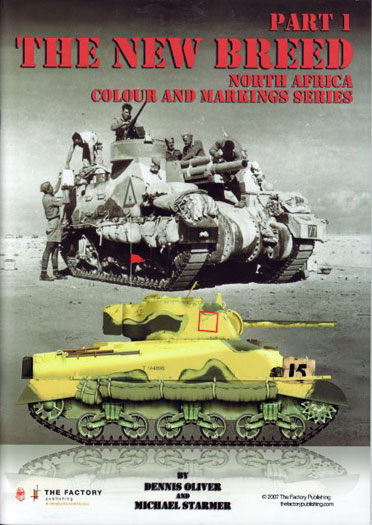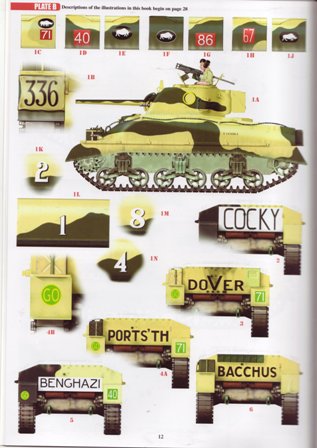|
|
|
|
| Home > Reviews > Britain > Part 1 - The New Breed NORTH AFRICA COLOUR AND MARKINGS SERIES by Dennis Oliver & Michael Starmer |
Part 1 - The New Breed
NORTH AFRICA COLOUR AND MARKINGS SERIES
by Dennis Oliver & Michael
Starmer

Reviewed by Alastair Bowie
Summary
|
Title: |
Part 1 – The New Breed – North Africa Colour and Markings series |
|
ISBN: |
978-0-9804631-0-1 |
|
Media and Contents: |
Soft cover A4 portrait style with 33 pages including 12 of colour plates and B&W photos plus diagrams |
|
Price: |
TBA |
|
Review Type: |
First Read |
|
Advantages: |
A good one stop explanation of British Sherman and Priest colour schemes used in North Africa. Excellent reference for the modeller with detailed colour plates |
|
Disadvantages: |
Only 33 pages, untitled appendix |
|
Recommendation: |
Highly Recommended |
|
Publisher |
FirstRead
Disclaimer: In the interests of fairness, openness and objectivity the reviewer declares up front that he is a personal friend of the Author. Despite this I hope you find this a factual and objective review.
|
Probably the most important allied vehicle of WW2 was the oft maligned M4 Sherman in its many guises and configurations. The Sherman owes it parentage to the earlier M2 and M3 Mediums as does an equally important armoured vehicle the M7 “Priest” Self propelled howitzer. These vehicles were designed based on the experiences of armoured warfare in early World War Two and saw their combat debuts with the British 8th Army in North Africa. These vehicles arrived at just the right time for the battered 8th Army who had been depleted of quality vehicles, AFV’s and troops for the ill fated and wasteful Greek and Cretan campaigns and suffered at the hands of Rommels Afrika Korps (DAK). In fact, there was the real possibility that the 8th Army might lose the Canal and Cairo to an apparently unstoppable DAK. Into this scenario arrived the US Medium which the Brits christened General Sherman as was the practice at the time for US supplied Vehicles to be named after US Civil War Generals. The M7 105mm Howitzer Motor Carriage arrived alongside the Sherman and was named “Priest” due to its pulpit like AA gun mount beginning a tradition of naming SPG after ecclesiastical titles or themes which was to last until the 1990s. This book, the first of a series on North African Armour deployed Armour, is a collaborative effort between two well known Authors Dennis Oliver & Mike Starmer. Dennis had previously released a few related titles such as Codename Swallow , The British Sherman . Mike had produced a series of colour and marking guides for Brit Armour including “The Caunter Scheme” and “Alamein and After”. Between them they have set about answering a lot of the questions regarding what vehicles were used by whom and how they appeared in service. This subject is a minefield and unlike Late war German armour where they have almost identified each individual vehicle, the type of paintprush used to paint them, the day they were painted and what the painter was wearing, British Desert schemes and markings have been covered in little detail to date. There have been excellent publications on colour and markings but this is the first seen by this reviewer that ties the theory and the practical application in one publication.
Click the thumbnails below to view larger images: The book is in an A4 format with a softcover with the now obligatory centre colour profiles. It is only 33 pages long and one of these is the inside of the back cover! So, what’s in it? The book begins with the history of the M4 and M7 in NA followed by general notes including:
The next subject is an in depth look at the camouflage applied which will answer a lot of modellers questions. Following this is a list of the British Armoured units in Oct 1942 (It is actually includes post Oct formations) that used either the Sherman or Priest. This covers 8th Army
1st Army (Tunisia)
This section gives notes on the markings and schemes for the various sub units of the parent formation. It describes which vehicle types were in use and where possible refers to reference photos (usually IWM) or texts which is welcome for those who like to do further research. The heart of the Book is the excellent series of colour plates which adorn the centre pages. There are side profiles and scrap shots of detail such as turrets, noses, rears, fender markings etc. These are superb and although you may have seen one or two in other publications the scrap details are a superb addition. There are twelve full pages with detailed notes applying to each page and subject depicted. Three pages are devoted to the M7 HMC and the rest cover the M4A1 and M4A2 Sherman’s. The depictions of the Sherman’s has improved and cover the details of the real vehicles such as type of Bogies , riveted or welded lower hulls, sand shields and sunshield rails etc. An Appendix section rounds out the book and this was one area I thought could have been done better. The Appendix’s are labelled 1 through 5 but do not have any appendix title. The reader either has to refer back in the text or have good subject knowledge to understand what they are (other than App 5) The following are the Appendixes:
Black and white photos appear throughout the book and are mainly IWM collection sourced but others are from the Alexander Turnbull library and private sources. These are generally well reproduced but I noticed some were a bit dark which in all probability is down to the original. A lot (almost all) of these have been seen before but never before in one single publication. In Summary this is a welcome and useful book on the early employment of the Sherman and Priest in WW2. It offers well researched and detailed Colour plates suitable for the modeller. Importantly Mike and Dennis have unravelled a lot of the mysteries of 8th and 1st Army markings and schemes which prove once again that Sherman’s are not all OD and have interesting colour schemes. It is the first to tackle the complex subject of the 1st Army Shermans in Tunisia and worth the purchase for that information alone. My only reservations are as previously mentioned, the appendix listing and one thing I’d like to see is a picture reference for the colour plate subjects but that is just a personal preference. This book comes ate a time where model subjects of these important subjects are becoming available. As such it will appeal to those modellers wishing to build the new Academy M7 in other than the kit supplied schemes. Dennis has depicted a great variation of schemes and these should appeal to the modeller. Highly recommended to the Wargamer, Modeller or Historian Review Sample supplied by the Author |
Text and Images by Alastair
Bowie
Page Created 30 December, 2007
Page Last Updated
29 December, 2007



